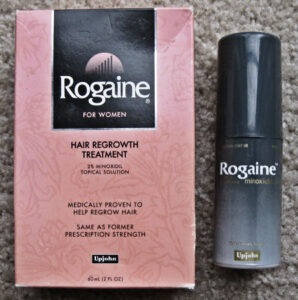How to Treat Hair Loss in Women
Many women experience hair loss.
The causes are many and include chemotherapy, aging, hormonal changes, nutritional deficiencies, thyroid abnormalities, and certain medications (such as isotretinoin, warfarin, tamoxifen, lithium).
Often times, the hair loss is caused by too much of a hormone called dihydrotestosterone, which can cause hair loss by shrinking hair follicles (the hair tunnels beneath the skin where hair grows) in both men and women.
{RELATED POST:4 Surprising Medical Reasons for Hair Loss.}
Before you read on, check out this excellent summary of treatment options for hair loss from a Board-Certified Dermatologist:
FIRST-LINE HAIR LOSS THERAPY FOR WOMEN
Minoxidil Topical Solution or Foam: For female hair loss, we recommend Minoxidil 2% or 5% topical solution or foam (Rogaine for Women), which can be bought over-the-counter. You may initially lose hair for the first 2 to 6 weeks. Do not let the initial hair loss alarm you. It can take 4 months or longer to begin to see improvement, so patience is key here. Expect to use minoxidil for at least a year. You can also use minoxidil if you have lost your hair from chemotherapy. Minoxidil can also accelerate your hair growth after chemotherapy, but it will not prevent hair loss.
If you stop applying Minoxidil, then the hair growth effects of this medicine will stop working. We also recommend a healthy diet and a multivitamin to ensure your hair loss is not caused by a vitamin or nutrient deficiency. The side effects of minoxidil are mild, the most common being skin irritation if you take a dose higher than what is recommended on the instructions.
Before we move on to discuss second-line hair loss therapies for women, watch this video from Dr. Oz discussing hair loss scams targeting women.
SECOND-LINE HAIR LOSS THERAPIES FOR WOMEN
If minoxidil (Rogaine for Women) does not work after at least one year of treatment, you may want to ask your Dermatologist about getting a prescription for spironolactone. You should also continue taking minoxidil while taking spironolactone. Keep your expectations in perspective, however, because there is not a lot of data to show spironolactone is effective for female hair loss.
Spironolactone: This medication works by blocking the production of dihydroxytestosterone, which leads to hair loss. You should take this medication for at least 6 months to determine if it is working. You should also continue taking topical minoxidil while taking spironolactone.
Side effects of spironolactone include include lower sex drive, menstrual irregularities, low blood pressure, and high blood potassium levels. Your doctor will let you know how often your blood pressure and potassium levels will need to be checked. You should AVOID spironolactone if you are pregnant. If you are of a child-bearing age, you will want to take spironolactone with an oral contraceptive to prevent pregnancy.
Finasteride: Finasteride (Propecia) works well for male hair loss, but medical studies have shown conflicting results in women. Additionally, finasteride is unsafe to use if you are pregnant. There, we do NOT recommend finasteride to treat hair loss in women.
Flutamide: Flutamide requires a prescription and is approved for use in male prostate cancer. We do NOT recommend flutamide to treat hair loss in women. There is some data to show it helps with hair loss in women, but this drug can be toxic to the liver.
OTHER HAIR LOSS THERAPIES FOR WOMEN
Biotin: We are neither for or against using Biotin for female hair loss. There is not much medical evidence that Biotin works for hair loss in women, but it doesn’t hurt to try. You can even combine it with Zinc, which is found in a daily multivitamin. Just do not take more than 2,500 mcg per day. Biotin doses of 5,000 mcg or higher have been known to alter certain lab tests such as thyroid tests. We recommend Nature Made’s Biotin 2500mcg, which you can purchase from Amazon by clicking here.
Cimetidine (Tagamet): Cimetidine is normally used for heartburn or acid reflux. In one small study, 7 white women who took cimetidine 300 mg by mouth five times a day for up to 9 months showed good to excellent regrowth of hair. Please talk to your doctor first before using cimetidine for hair loss, especially since cimetidine has a lot of drug interactions.
Cooling Caps: Cooling caps such as Arctic Cold Cap or DigniCap may be useful to slow down hair loss in women undergoing chemotherapy for breast cancer. Cooling caps are worn about an hour before a chemotherapy infusion and kept on for several hours after the infusion is over. Cooling caps work by constricting blood vessels in the scalp, which slows down chemotherapy from traveling to the scalp and causing hair loss. One study showed cooling caps slowed down hair loss in 67 out of 101 women undergoing chemotherapy for breast cancer. You may still lose hair, but not as much as you would without a cooling cap. So, if you plan to undergo chemotherapy infusions and are concerned about hair loss, you may want to consider a cooling cap. Cooling caps are not recommended if you will be receiving an anthracycline-based chemotherapy like doxorubicin. Costs vary by manufacturer (As of August 2020, Arctic Cold Cap cost about $380 per month). You may want to check to see if your health insurance covers cooling caps as well.
Essential Oils: We are neither for or against using essential oils for female hair loss. There is not much medical evidence that essential oils work for hair loss, but it doesn’t hurt to try. One small study showed that massaging essential oils (thyme, rosemary, lavender, and cedarwood) in a mixture of carrier oils (jojoba and grapeseed) into your scalp daily can potentially improve hair growth.
Estrogen: We do NOT recommend high dose estrogen to treat hair loss in women. There is not enough data to show it is safe and effective for female baldness. Plus high dose estrogen can cause side effects such as clotting.
Hair Transplant Surgery: If other methods are not effective, hair transplant surgery may be an option. Hair from other parts of your scalp (usually the back of your head) are transplanted into the bald areas of your scalp. The downside of hair transplant surgery is the high cost, risk of infection and pain, and possibility that it will not work.
Ketoconazole 2% shampoo: Ketoconazole 2% shampoo can reduce the production of testosterone on the skin and has been shown to be mildly effective in men with hair loss. There is not enough data to show that ketoconazole shampoo is effective for female hair loss, but it does not hurt to try. Ketoconazole 2% shampoo is available by prescription only. This shampoo is used two to four times every week. There is also a lower strength Ketoconazole 1% shampoo (Nizoral) that is available over-the-counter, but it make not work as well.
Laser Light Therapy: Low-level laser light therapy (also known as photobiomodulation therapy) stimulates stem cells at the base of your hair follicles to increase energy production for more hair growth. Low-level laser light therapy is available as two forms: laser comb or laser helmet.
The laser comb is a comb device that is used three times per week. Some small studies showed benefit in increasing hair density in both men and women. No side effects were noted. We are neither for or against using low-level laser light therapy for female hair loss. There is not much medical evidence that low-level laser light therapy works for hair loss, but it doesn’t hurt to try.
The laser helmet or cap include products such as Capillus, Handi-Dome, LaserCap LCPro, and Theradome. The directions for use vary by manufacturer but they are typically worn for about 30 minutes every other day or twice weekly. But treatment is not cheap. As of August 2020, Capillus costs $800 for a 5 month treatment.
Latanoprost: Latanoprost is a medication that is approved to treat an eye condition called glaucoma, but 1 small study showed benefit in hair growth for men. We do NOT recommend latanoprost to treat hair loss in women because there are no studies to show that it is effective in women for hair loss.
Minoxidil tablets: We do NOT recommend minoxidil tablets because it has similar effectiveness as the topical solution, but with more side effects. Side effects may include excessive hair growth all over the body and mild increase in heart rate.
Oral Contraceptives: Oral contraceptives are not very effective when used alone for female hair loss. Oral contraceptives are usually combined with more effective drugs like spironolactone and minoxidil topical solution. Oral contraceptives will also prevent you from getting pregnant while taking drugs that can harm the fetus such as spironolactone. If your doctor prescribes you an oral contraceptive, make sure it contains desogestrel, norgestimate, or drospirenone. These newer generation contraceptives seem to be more effective because they have less androgen than other contraceptives. Just be aware that oral contraceptives carry the risk of blood clots, especially for smokers over 35 years old.
Platelet rich plasma (PRP): Some studies indicate benefit in both men and women, but PRP treatment is very expensive. One study showed increase hair density and both men and women 6 months after starting treatment. More data is needed before we can recommend PRP for hair loss in women.
Saw Palmetto: There is not enough medical evidence to recommend Saw Palmetto for hair loss in women. One small trial showed hair growth benefit in 6 men.
Zinc: We are neither for or against using Zinc for female hair loss. There is not much medical evidence that Zinc works for hair loss in women, but it doesn’t hurt to try. You can even combine it with Biotin. For adult women, we recommend an adequate daily intake of 8 mg, which you can get from a daily multivitamin.
CONCLUSION
In conclusion, we recommend you first try topical minoxidil foam or solution (Rogaine for Women) for hair loss in women. Be patient as it will take 4 months to 1 year to see its full effects, and you may lose hair in the beginning. We also recommend a healthy diet and a multivitamin to ensure your hair loss is not caused by a vitamin or nutrient deficiency. Also, keep your expectations in perspective at it may or may not work. If this medication does not work, please consult your Dermatologist for further treatment options.
Pharmacy Health Tips Medical References
Sources
Arch Dermatol 2018
Dermatol Surg 2016
Int J Dermatol. 1987
JAMA 2017



